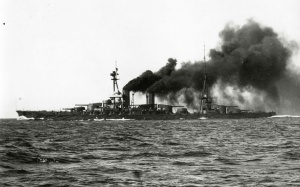Ise-class battleship
Description
The Ise-class battleship (伊勢型戦艦, Ise-gata senkan) was a class of 2 battleships built for the Imperial Japanese Navy during World War I.
Vehicles
Rank VI
Vehicles are listed in order of refit year, not build year
Armament comparison
This comparison is intended to offer a bird's eye view. For more detailed information, please, refer to the individual articles.
| Vessel | Rank | BR (RB) | Primary armament | Secondary armament | Anti-aircraft armament | Other | |
|---|---|---|---|---|---|---|---|
| |
IJN Hyuga | 6 x 2 (356 mm) | 20 (140 mm) | 6 (7.72 mm) | 6 x 533 mm torpedo | ||
| |
IJN Ise | 6 x 2 (356 mm) | 16 (140 mm) | 4 x 2 (127 mm) + 10 x 2 (25 mm) | 3 x Aichi E13A1 | ||
History

The Ise-class battleships (伊勢型戦艦) were built for the Imperial Japanese Navy, comprising Ise and Hyuga. Initially intended as the third and fourth ships of the Fusō-class, but the scope of modifications needed lead to the creation of the whole new class. Construction of Ise began in December 1915, and she was launched on 12 November 1916, while Hyuga was laid down in May 1915 and launched on 27 January 1917. Both vessels were commissioned in 1917.
The main improvements over the Fusō-class included a revised arrangement of the main battery, which enhanced their use by reducing blast effects and improving overall gun handling. The elevation of the main guns was initially designed to reach +25°, but was later increased to +30° in 1921, along with upgraded rangefinders and improved fire control systems for long-range combat. The Ise-class also adopted semi-automatic loading for the main guns, an improvement over the Fusō's fixed loading system. The secondary armament was reduced from 152 mm to 140 mm to enhance handling and rate of fire. This reduction in calibre was compensated by an increase in the number of guns, from 16 to 20. However, the internal layout remained cramped, with some guns positioned in less-than-ideal locations. Armour protection saw some improvements in arrangement and thickness, but it still fell behind the standard set by the Battle of Jutland. The Ise's also suffered from poor habitability and difficult steering, with limited space for the crew and poor course-keeping ability, although manoeuvrability was reported to be easier and an improvement over her predecessor.
Both battleships of the class saw limited action in the early stages of World War II, primarily serving in training and reserve roles. However, after Japan's defeat at the Battle of Midway in 1942, they were converted into hybrid battleship-aircraft carriers. Their aft turrets were removed to accommodate a flight deck capable of launching 22 aircraft, though neither vessel carried aircraft during combat operations.
In October 1944, the Ise and Hyuga participated in the Battle of Leyte Gulf as part of Carrier Division 4, Northern Force, under Admiral Ozawa. They survived multiple air attacks despite suffering heavy damage. By 1945, they were effectively relegated to anti-aircraft defence due to shortages of fuel, aircraft, and trained pilots. Both ships sustained further damage from air raids during July 1945, ultimately sinking in shallow waters near Kure. The wrecks were scrapped post-war, with Hyuga dismantled in July 1946 and Ise shortly thereafter.
External links
- [Wikipedia] Ise-class battleship
- [大日本帝国軍 主要兵器] 『伊勢型戦艦』【Ise-class battleship】
- [Combined Fleet] Ise-class Battleship
- [Naval Encyclopedia] Ise class battleships (1917)
- [The Pacific War Online Encyclopedia] Ise Class, Japanese Battleships
- [WW2 Cruisers] Ise Class BB
- [World War II Database] Ise-class Battleship
- [The Dreadnought Project] Ise Class Battleship (1916)
- [Navypedia] ISE battleships (1917 - 1918)
| Japan battleships | |
|---|---|
| Kawachi-class | IJN Settsu |
| Fusō-class | IJN Fuso · IJN Yamashiro |
| Ise-class | IJN Ise · IJN Hyuga |
| Kongō-class | IJN Kongo · IJN Haruna |
| Nagato-class | IJN Mutsu |



